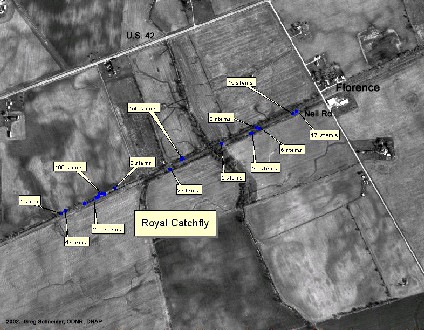Ohio-Erie Trail Bikeway
-- Study and Management of Prairie Remnants


The presettlement
SW Ohio landscape was once domnated by
These forests and grasslands were converted to cropland
forests
that were interspirsed with areas of grassland (or prairie).
as shown in the above view of the "Selma Plains", Selma, OH.


But, remains
of the historic Ohio prairies ("priaire remnants") exist in old cemeteries
(which were protected from plowing) and along railways
(promoted
by the frequent fires and mowing) as may have been the case with the remnants
shown above along U.S. 42 near Selma, Ohio.


Now
that the railway has been converted to bikeway (Ohio-Erie Trail) and fire
is suppressed, prairie remnants must be maintained by
a careful plan of mowing, cutting, and prescribed fire in spring or after
the growing season. "County Line" remnant near Selma, OH.


Research
opportunities include inventory and GPS mapping of plant species along
the bikeway (former railway) corridor between Xenia, OH
and Columbus, Ohio. Greg Schneider, botanist with ODNR,
Div. of Natural Areas and Preserves views Royal Catchfly (Silene
regia).
Possible Research Topics:
1. Extending plant species inventory
and GPS mapping -- what species inhabit the bikeway prairie remnants?
2. What combination of seasonal
mowing and prescribed burns is best to enhance the prairie remnants?
3. How are butterfly, bird, or other
selected animal populations affected by remnant prairie restoration?
4. How do bird and butterfly species
richness of bikeway prairie remnants compare to those of the Cedarville
U. Prairie?
5. What is the history of land use
of the "Selma Plains" as obtained from county archives and interviews of
residents?
6. What interactions exist between
prairie plant and animal populations (see below)?


We have observed
an adult weevil that clips the flower stalk of prairie dock (Silphium
terebinthinaceum (pinnatifid), shown above.
According to
John Tooker (Univ. of Illinois at Urbana-Champaign) the weevil lays
its eggs in the flower head where the resultant larvae develop
at the expense
of reproductive success of the plant. What is the effect of
periodic fire upon weevil populations?









